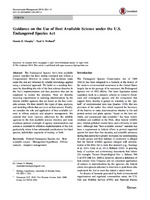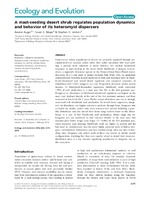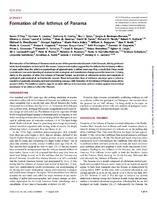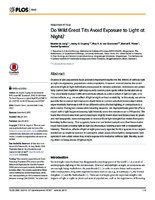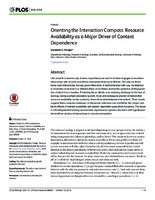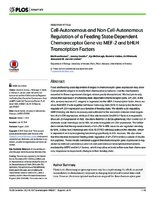If you have any problems related to the accessibility of any content (or if you want to request that a specific publication be accessible), please contact us at scholarworks@unr.edu.
Browsing Biology - Faculty Research by Issue Date
Now showing items 21-40 of 142
-
.
.
.
miR-124 Regulates the Phase of Drosophila Circadian Locomotor Behavior
(2016)Animals use circadian rhythms to anticipate daily environmental changes. Circadian clocks have a profound effect on behavior. In Drosophila, for example, brain pacemaker neurons dictate that flies are mostly active at dawn ... -
.
.
.
Estimating species richness using environmental DNA
(2016)The foundation for any ecological study and for the effective management of biodiversity in natural systems requires knowing what species are present in an ecosystem. We assessed fish communities in a stream using two ... -
.
.
.
Guidance on the Use of Best Available Science under the US Endangered Species Act
(2016)The Endangered Species Act's best available science mandate has been widely emulated and reflects a Congressional directive to ensure that decisions made under the Act are informed by reliable knowledge applied using a ... -
.
.
.
A mast-seeding desert shrub regulates population dynamics and behavior of its heteromyid dispersers
(2016)Granivorous rodent populations in deserts are primarily regulated through precipitation-driven resource pulses rather than pulses associated with mast-seeding, a pattern more common in mesic habitats. We studied heteromyid ... -
.
.
.
Essentiality Is a Strong Determinant of Protein Rates of Evolution during Mutation Accumulation Experiments in Escherichia coli
(2016)The Neutral Theory of Molecular Evolution is considered the most powerful theory to understand the evolutionary behavior of proteins. One of the main predictions of this theory is that essential proteins should evolve ... -
.
.
.
The Molecular Chaperone DnaK Is a Source of Mutational Robustness
(2016)Molecular chaperones, also known as heat-shock proteins, refold misfolded proteins and help other proteins reach their native conformation. Thanks to these abilities, some chaperones, such as the Hsp90 protein or the ... -
.
.
.
The Many Dimensions of Diet Breadth: Phytochemical, Genetic, Behavioral, and Physiological Perspectives on the Interaction between a Native Herbivore and an Exotic Host
(2016)From the perspective of an herbivorous insect, conspecific host plants are not identical, and intraspecific variation in host nutritional quality or defensive capacity might mediate spatially variable outcomes in plant-insect ... -
.
.
.
Confronting species distribution model predictions with species functional traits
(2016)Species distribution models are valuable tools in studies of biogeography, ecology, and climate change and have been used to inform conservation and ecosystem management. However, species distribution models typically ... -
.
.
.
Genetic variation and population structure in a threatened species, the Utah prairie dog Cynomys parvidens: the use of genetic data to inform conservation actions
(2016)The Utah prairie dog (Cynomys parvidens), listed as threatened under the United States Endangered Species Act, was the subject of an extensive eradication program throughout its range during the 20th century. Eradication ... -
.
.
.
Quantification of mesocosm fish and amphibian species diversity via environmental DNA metabarcoding
(2016)Freshwater fauna are particularly sensitive to environmental change and disturbance. Management agencies frequently use fish and amphibian biodiversity as indicators of ecosystem health and a way to prioritize and assess ... -
.
.
.
Formation of the Isthmus of Panama
(2016)The formation of the Isthmus of Panama stands as one of the greatest natural events of the Cenozoic, driving profound biotic transformations on land and in the oceans. Some recent studies suggest that the Isthmus formed ... -
.
.
.
Do Wild Great Tits Avoid Exposure to Light at Night?
(2016)Studies of wild populations have provided important insights into the effects of artificial light at night on organisms, populations and ecosystems. However, in most studies the exact amount of light at night individuals ... -
.
.
.
Orienting the Interaction Compass: Resource Availability as a Major Driver of Context Dependence
(2016)Life on earth is enormously diverse, in part because each individual engages in countless interactions with its biotic and abiotic environment during its lifetime. Not only are there many such interactions, but any given ... -
.
.
.
Forecasting the Impacts of Silver and Bighead Carp on the Lake Erie Food Web
(2016)Nonindigenous bigheaded carps (Bighead Carp Hypophthalmichthys nobilis and Silver Carp H. molitrix; hereafter, "Asian carps" [AC]) threaten to invade and disrupt food webs and fisheries in the Laurentian Great Lakes through ... -
.
.
.
Fine-scale genetic structure among greater sage-grouse leks in central Nevada
(2016)Mating systems that reduce dispersal and lead to non-random mating might increase the potential for genetic structure to arise at fine geographic scales. Greater sage-grouse (Centrocercus urophasianus) have a lek-based ... -
.
.
.
Contralateral migration of oculomotor neurons is regulated by Slit/Robo signaling
(2016)Oculomotor neurons develop initially like typical motor neurons, projecting axons out of the ventral midbrain to their ipsilateral targets, the extraocular muscles. However, in all vertebrates, after the oculomotor nerve ... -
.
.
.
Cell-Autonomous and Non-Cell-Autonomous Regulation of a Feeding State-Dependent Chemoreceptor Gene via MEF-2 and bHLH Transcription Factors
(2016)Food and feeding-state dependent changes in chemoreceptor gene expression may allow Caenorhabditis elegans to modify their chemosensory behavior, but the mechanisms essential for these expression changes remain poorly ... -
.
.
.
CircRNA accumulation in the aging mouse brain
(2016)Circular RNAs (circRNAs) are a newly appreciated class of RNAs expressed across diverse phyla. These enigmatic transcripts are most commonly generated by back-splicing events from exons of protein-coding genes. This results ... -
.
.
.
Dscam1 Forms a Complex with Robo1 and the N-Terminal Fragment of Slit to Promote the Growth of Longitudinal Axons
(2016)The Slit protein is a major midline repellent for central nervous system (CNS) axons. In vivo, Slit is proteolytically cleaved into N- and C-terminal fragments, but the biological significance of this is unknown. Analysis ... -
.
.
.
The path back: oaks (Quercus spp.) facilitate longleaf pine (Pinus palustris) seedling establishment in xeric sites
(2016)Understanding plant-plant facilitation is critical for predicting how plant community function will respond to changing disturbance and climate. In longleaf pine (Pinus palustris Mill.) ecosystems of the southeastern United ...
 University of Nevada, Reno
University of Nevada, Reno





